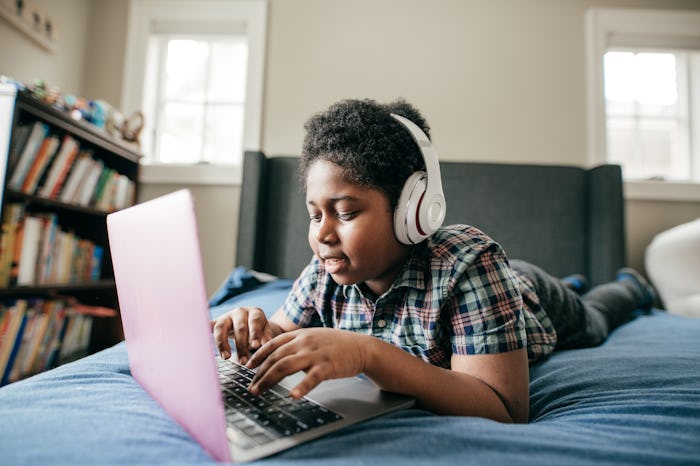Life

What Experts Want You To Know About Your Child's Posture During Remote Learning
With so many kids distance learning and sitting in all different chairs, on the floor, the sofa, wherever — you begin to wonder about the effect it is having on their backs. I mean, there was a run on desk chairs for adults back in March, so it makes sense that remote learning can affect kid's posture, too. But is it doing a lot of damage? And how can you fix it?
As it turns out, remote learning might be killing your kid's posture for real. While it's not a permanent change — and certainly not our biggest worry at the moment — it's a good thing to be cognizant of when helping your children set up their learning space. "After just the first two months of distance learning before summer break, I saw a significant increase in children in my clinic with complaints of back and neck pain," physical therapist Dr. Wendy Cao Noakes tells Romper. This is obviously worrisome because children who are uncomfortable are not going to be as keen to sit in on Zoom meetings with their classroom, which means that we are stuck trying to figure out how to explain things like magnetics and multiplying fractions. (Which I am not great at doing.)
Megan Flores, Assistant Professor of the Doctor in Physical Therapy Program at the University of St. Augustine for Health Science, says that while it's possible that remote learning is killing your kid's posture, it really depends on the age of the child and the type of distance learning. "If children are constantly looking at a screen and sitting in the same chair for hours at a time, they are at risk for developing poor habits when it comes to posture," Flores says. "Younger children move — and wiggle — more. They have a harder time keeping still, so they do not necessarily develop the bad habits many of us have when sitting in front of a computer. Older children who are in middle school or high school are able to sit for longer periods, and are at risk for developing the rounded shoulders and forward head that is a hallmark of poor posture."
And it's also worth mentioning that your child's posture can directly relate to how they learn. If they're uncomfortable, chances are that they won't be paying attention as much as they would be if they felt good in their space and chair.
There is a solution to this problem, thankfully. It's all about designating a work area, and encouraging movement. I understand this is almost impossible for those of us in small spaces. I live in a very small Brooklyn apartment, so I get it. Cao Noakes says that you should make sure you children can have their feet flat on the floor, their knees "just below hip level," and the screen at eye level. "Elbows should also be at 90 degrees if typing, but most kids are just watching the screen or using the mouse, so this is not as important. A mouse instead of using the trackpad is a good option."
But keep your kids moving, too. Flores suggests encouraging your children to take standing and moving breaks every 30 minutes or so. Not only will it help them get their wiggles out, it is also good for resetting that posture. She agrees with Cao-Noakes that the screen should be eye-level when possible, whether you're propping up a laptop or an iPad, and that feet should be on the floor. It's all so simple in theory, but watching my children for 10 minutes, as they fold themselves into pretzels while doing their work, I know that it's going to take some effort. If only I were a better model. (Time to get an actual office chair, I suppose.)
Experts:
Dr. Wendy Cao Noakes, physical therapist
Megan Flores, PT, MPT, PCS, Assistant Professor of the Doctor in Physical Therapy Program at the University of St. Augustine for Health Science in Austin, Texas
This article was originally published on